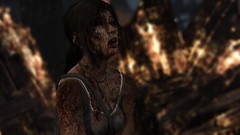Gamers of a certain age can’t help but remember the first time Lara Croft strolled onto the screen in 1996’s Tomb Raider. Wearing only micro-rise hot pants, a painted-on tank top, and an over-serious expression, the polygonal pinup seemed the confirmation of every unfortunate gaming stereotype. Despite all the cheesecake, though, the title turned out to be pretty darn good, and its combination of exploratory acrobatics and blasting baddies with pistols akimbo soon made the nubile riff on Indiana Jones a household name. But it wasn’t destined to last. Increasingly mediocre sequels followed, and Tomb Raider’s original publisher shut its doors in the mid-2000s. Although a few moderately successful spinoffs followed, it seemed as though Lara Croft might stay buried forever. Then in 2013, developer Crystal Dynamics decided to completely reimagine the character Guinness World Records declared “The Most Successful Human Virtual Game Heroine.”
And they did so by beating the ever-loving pudding out of her.
While the new Tomb Raider’s prologue isn’t exactly inspired, it sets up the new Lara’s development rather well. Straight from her graduate studies, the fresh-faced archeologist joins the vessel Endurance, an exploratory vessel hired by the shifty publicity-hound Dr. James Whitman. A scholar fallen on hard times, Whitman hopes to find his way back into the limelight by discovering the mythical land of Yamatai. But when the ship breaks apart in a freak storm while sailing through the infamous Devil’s Triangle, the expedition becomes a living hell. Separated from her friends, marooned on a mysterious island, stripped of supplies, and pursued by members of murderous cult, Lara will have to learn how to survive—and how to kill.
If you never played the original Tomb Raider, you have to understand something: Lara Croft was the boss. Cool, confident, and impossible proportioned, she could scramble through traps and make epic leaps with a sardonic sneer on her face. The new Lara, though? She’s exactly the opposite. Callow. Cowed. Quickly bloodied. The game’s first cutscene ends with an antagonist knocking her cold, and she awakes hanging a cave ceiling by her feet. After managing to set her bonds on fire, she plummets to the floor only to impale herself on a protruding spike. Her shriek of pain is just the beginning of Lara’s aural agony. She gutturally grunts after missing jumps, gasps when grazed by gunfire, and screams in pure torment while cauterizing a grievous wound. Successful sorties hardly prove less traumatic, Lara’s petite frame a definite disadvantage during combat with larger male opponents. (Crystal Dynamics has made the new character model only improbably attractive this time around.) She staggers when striking out with a climbing ax, putting her full weight behind each stroke. Enemies nearly drag her off her feet when she attempts to stealthily strangle them with a bowstring. And once she gets her pair of iconic pistols during the final battle, the controls turn wobbly as she struggles with the guns' recoil and weight. I haven’t even gotten to the cringe-inducing death animations. Spastic writhing as a cave in crushes Lara’s skull. A bullet messily blasting through her brainpan when she attempts to wrest a gun from an assailant. A ride down a rushing river suddenly terminating as an extruding branch pierces the flesh beneath her chin and punches out through her head.
You get the picture: The whole thing is upsettingly violent.
Indeed, the Tomb Raider reboot’s grue has drawn the ire of some critics. “The essence of the issue for me is that Lara is entirely reactionary,” says Ben "Yahtzee" Croshaw of Zero Punctuation. “So you can kill a man and take a machete like a champ. A concrete block can do that. But you can’t kick one out of the back of a moving truck and call that a character arc.” A fair enough critique, as is the suggestion that inflicting such torments on Lara impugns the developers’ chivalry. But both assertions overlook Crystal Dynamic’s original intent: They were first and foremost trying to create a foil, a character who strongly contrasted with the near-caricature that inspired her. And whatever plot-related or thematic shortcomings that constantly keeping their protagonist bloodied and bruised might’ve caused (and they’ve caused plenty, in my humble opinion), they certainly hammered out an effective one.
(Picture: CC 2013 by Joshua Livingston)


No comments:
Post a Comment